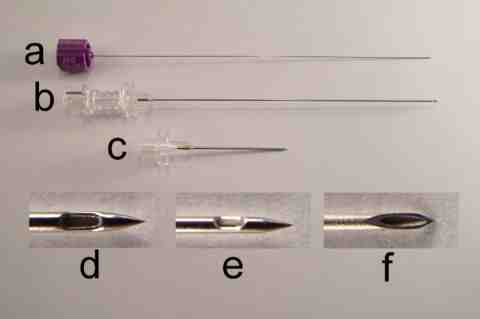Needle Types
Spinal needles are long, flexible and of small gauge (typically 22 – 27 gauge) and are available with differing types of tip. The size of the needle and its tip shape affect its performance (see Fig 1). The commonly used smaller needles are passed through a larger gauge introducer, and have an obturator which should always be in place when the needle is advanced, as it confers structural rigidity, which reduces the chance of tip shearing.

Spinal needles are long, flexible and of small gauge (typically 22 – 27 gauge) and are available with differing types of tip. The size of the needle and its tip shape affect its performance (see Fig 1). The commonly used smaller needles are passed through a larger gauge introducer, and have an obturator which should always be in place when the needle is advanced, as it confers structural rigidity, which reduces the chance of tip shearing.
Tips. Conical-elliptical tipped needles, such as the Sprotte and Whitacre (sometimes called 'atraumatic' needles), are associated with a lower incidence of dural puncture headache than needles with cutting tips (Quincke). This is thought to be because they part rather than slice the fibres of the meninges, allowing less leakage of cerebrospinal fluid and promoting faster healing

Spinal needles are long, flexible and of small gauge (typically 22 – 27 gauge) and are available with differing types of tip. The size of the needle and its tip shape affect its performance (see Fig 1). The commonly used smaller needles are passed through a larger gauge introducer, and have an obturator which should always be in place when the needle is advanced, as it confers structural rigidity, which reduces the chance of tip shearing.
Size. The smaller the needle, the lower the incidence of post dural puncture headache. Typically, needles of 24 gauge or smaller are used. The incidence of headache is <1% with these needle gauges, when combined with an atraumatic tip (assuming a single pass of the needle). Disadvantages of the very smallest needles include their physical flexibility and the slow rate of fluid flow through them.
